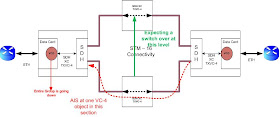“There
is member Failure in my VCG----- Link is going Down”
We may often come across such a problem. I am saying this taking a cue from the
previous post and also the kind of cases the operations me come across with.
My friends from the transport group, who have recently
plunged into this field (EOS) should be
actually conversant about three things over here.
1.
VCG: Stands for Virtual Concatenation Group and
this only sits on the Card or module that is responsible for the encapsulation
of Ethernet to SDH and having the GFP or GEoS object.
2.
LCAS:
Link Capacity Adjustment Scheme; and this deals with the Dynamic Payload
Control. This ensures that the entire link is not going down when only one
member of the VCG is going down. The
link below actually will describe LCAS in Detail and this is from the ITUT.
3.
Pass-through
Elements: These are
elements in the intermediate section of the link that only deals with the cross
connection between two different VCs. This doesn’t contribute to any kind of
data processing and only contributes to the channelization of the path for the
Data traffic.
A typical configuration of the link, in the
unprotected domain is shown as follows.
A thing to note in this link is that the drop points of
the SNCP connection are the Data card EoS objects and the LCAS is enabled also
at the Data card at the End Multiplexer. The work of the pass-through
object in this kind of connectivity is only limited to the SDH.
Also keep one thing in mind that the Pass-through
object does not in any way contribute to any data processing. The VC-4s are all
individual VC-4 that are connected by means of a cross connect fabric which is
purely TDM.
If we logically look at the implementation then the
implementation is actually perceived as follows.
As we can see in this figure, Ethernet processing, LCAS, Virtual
concatenation are all done on the terminal Data cards and they are the ones
which are actually also acting as the SNCP drop points. The SNCP switchover
also happens as the VC Members of the VCG on the DATA card and NOT ON THE SDH
card.
Now
why I am saying this? Let us look at a fault over here in the next figure.
As we can see that the complain is noted as one of the VC
in the line had an AIS which was hitting one of the members of the EoS group.
This was actually bringing the entire EoS group Down (Which it should not be).
However, the expectation of the person looking at this
fault maybe as follows (shown in the next figure).
As we can see in this figure that the fault attendant was
actually expecting the connection to switch at the pass through level, which
for obvious reasons as mentioned above should not be the expectation. This is
because the pass-through element is not having the protection connection and
nor having the information of any kind of grouping that should be there.
So the expectation that the switch should take place at the
pass through level is a wrong expectation in such kind of configurations.
So then how to
resolve this problem?
Ø First of all it
should be ensured that the LCAS is enabled at both the locations (end – points)
and are running the same variant and also are compliant with each-other.
Ø The SNCP
connection should be checked, because if the SNCP is perfect then there should
not be any kind of problem in switch-over. Actually the SNCP switch-over should
happen at the terminal end only for one VC-4 and this should not lead to the
link going down with LCAS enabled at both locations.
Ø The SNCP
variant that is being run should be made as a Non-intrusive SNCP which will
respond to also errors in VC. Please remember SNCP works on a VC-4 level
whereas the LCAS will work on the VCG (Multiframe level). And since in the
pass-through element there is neither SNCP or Virtual concatenation, this
operation is always done from the endpoints.
Hence, if we see clearly then the actual resolution should
be as shown in the figure below.
So what are the things to remember in such configurations?
1.
The traffic is Ethernet encapsulated in SDH and the
encapsulation and termination actually happens at the endpoints where the EoS
object or Virtual Concatenation Group is present. The SNCP connection endpoints
and the switching points are also present over there and not anywhere else.
2.
The pass-through element is just like a repeater which patches
the VC-4s. This is a point where we can actually have a J SWAP that is changing
of the VC-4 number like in any other TDM cross connect.
3.
Member going down should be addressed at the VCG level.
4.
Always keep the LCAS in synchronized mode.
5.
If required check trace of each and every VC-4.
6.
SNCP to be kept in non – intrusive mode.
So in the next post will share some interesting facts about implementing optimization in the LAN network using L2 devices and also the concept of Vlan. Till then.....Goodbye....





No comments:
Post a Comment